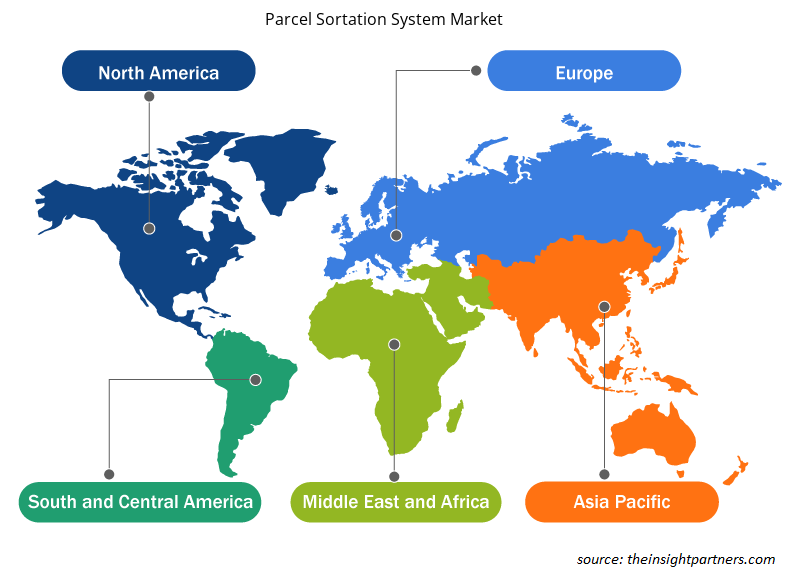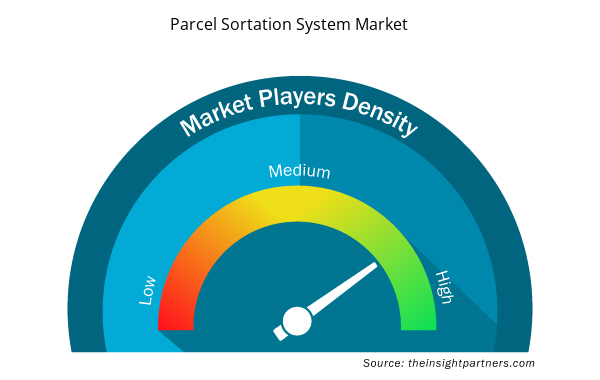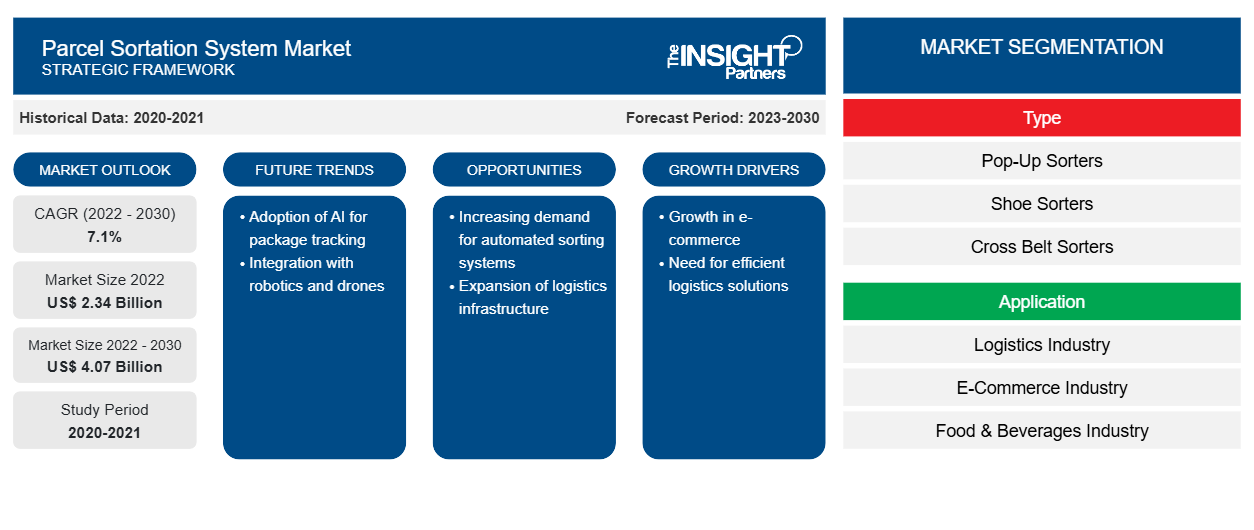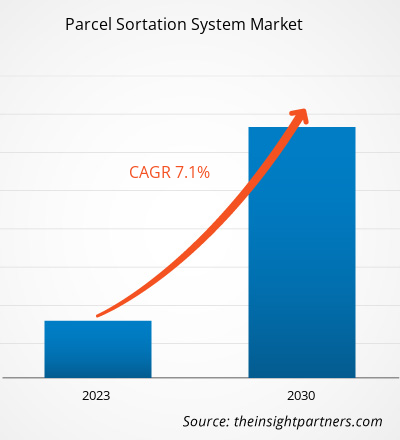[研究报告] 包裹分拣系统市场规模预计将从 2022 年的 23.4 亿美元增长到 2030 年的 40.7 亿美元;预计 2022 年至 2030 年的复合年增长率为 7.1%。
分析师观点:
随着技术的发展,包裹分拣系统行业在过去几年中发生了巨大变化。自动化技术对多个终端使用行业产生了积极影响,发达地区和发展中地区对各种自动化技术的采用不断增长。制造业是自动化技术的早期采用者之一,这主要归因于劳动力成本的增加和人口老龄化。由于制造业生产活动迅速增加以满足不断增长的客户需求,终端使用行业对包裹分拣系统的需求不断增长,从而推动了包裹分拣系统市场规模的扩大。
包裹分拣系统市场概况:
消费品产量的增加和电子商务领域的显著发展推动了包裹分拣系统市场的增长。然而,包裹分拣系统的使用技术复杂性限制了市场的增长。此外,仓库管理系统需求的不断增长和包裹分拣系统成本的总体下降预计将在未来几年为包裹分拣系统市场参与者提供充足的机会。
随着包裹分拣系统需求的不断增长,包裹分拣系统市场中的众多参与者都在投资新仓库以保持竞争力。这些公司正在开发新产品以保持其在全球包裹分拣系统市场中的地位。例如,亚马逊宣布投资 1 亿美元在墨西哥开设新的自动分拣系统仓库,其中包括其在人口稠密的首都地区以外的首批发货中心,以提供更快的送货服务。新站点包括两个履行中心——靠近北部城市蒙特雷和中部城市瓜达拉哈拉。该平台为从分拣系统中取出产品提供了多种选择——水平、下降、动力和重力变体提供紧凑和受控的分离。此外,Interroll 开发了一种新的进料装置,它正在扩展其模块化平台解决方案并实现高效的物料流。新的进料模块旨在与 Interroll 交叉带式分拣机配合使用。
定制此报告以满足您的需求
您可以免费定制任何报告,包括本报告的部分内容、国家级分析、Excel 数据包,以及为初创企业和大学提供优惠和折扣
- 获取此报告的关键市场趋势。这个免费样品将包括数据分析,从市场趋势到估计和预测。
包裹分拣系统市场的市场驱动因素:
消费品产量不断增加,自动化技术的应用日益广泛
全球人口的增长极大地增加了汽车、制药、零售、电子、食品和饮料以及许多其他行业对多种产品类别的需求。为了满足这种不断增长的需求,制造商正在做出各种努力来大幅提高产量,这产生了对分拣和存储设施的大量需求。仓库、存储中心和配送中心在维持各公司的消费品库存方面发挥着至关重要的作用。存储时对产品的损坏最小、存储成本低和易于分拣是高效存储和分拣系统的一些重要特征,这些特征促使制造商和供应链合作伙伴对其需求旺盛。
此外,全球范围内各种自动化技术的采用正在持续增长。由于劳动力成本的增加以及人口老龄化,制造业是自动化技术的主要采用者。自动化技术还促进了制造业增加产量并创造高收入。随着消费品数量的不断增加,包裹分拣设施中心面临着传统包裹分拣系统效率低下的挑战,例如分拣大量包裹、处理窗口变短以及技术错误增多。因此,为了克服这一挑战并轻松地按指定部分对包裹进行分拣,仓库、物流设施中心、机场和码头越来越多地采购自动化技术。这一因素推动了包裹分拣系统市场规模的扩大。
包裹分拣系统市场细分分析:
根据类型,包裹分拣系统市场细分为:
- 弹出式分类器
- 鞋子分类机
- 交叉带式分拣机
- 倾斜托盘分拣机
- 推盘
- 其他的
交叉带分拣机细分市场在 2022 年占据了包裹分拣系统最大的市场份额。交叉带分拣机是目前最快的分拣机之一,每小时可分拣多达 25,000 个单位。这使得它们成为任何需要高速分拣和吞吐量的流程的绝佳解决方案。交叉带分拣机有可能使涉及处理许多包含小立方体商品的小订单的电子商务运营受益。这些系统用于订单履行、装运、交叉对接、配套、商店退货和补货、混合邮件分拣以及入站分拣以存放货物等应用。
包裹分拣系统市场的区域分析:
全球包裹分拣系统市场大致分为五大区域:北美、欧洲、亚太地区、中东和非洲以及南美。由于强大的制造业基础、高劳动力成本以及政府推动自动化的举措,欧洲已成为包裹分拣系统市场的主要细分市场。其他各种因素,例如在主要城市和枢纽之间合理分布分拣中心,促进了跨境包裹流动和先进系统的采用,包括西欧汽车工业中的机器人。
预计亚太地区将在预测期内创下包裹分拣系统市场增长最快的纪录。人口大幅增长和可支配收入增加是该地区包裹数量增加的几个因素;因此,为了管理如此增加的数量,物流公司正在使用包裹分拣系统等先进技术。此外,快速发展的电子商务市场也催生了该地区对高效包裹分拣系统的需求。此外,中国和印度人口密集城市的分拣中心数量不断增加,推动了亚太地区包裹分拣系统市场份额的增长。
关键球员分析:
Bastian Solutions, LLC;Daifuku Co., Ltd.;Dematic;Honeywell International Inc.;Murata Machinery, Ltd;Interroll Group;BEUMER GROUP;Viastore Systems;Vanderlande Industries BV;和西门子物流有限公司是报告中的主要包裹分拣系统市场参与者。在这些参与者中,库卡股份公司、发那科公司、ABB 有限公司、川崎重工业有限公司和安川美国公司是包裹分拣系统市场前五大参与者,因为它们提供的产品组合多样化。
包裹分拣系统市场区域洞察
Insight Partners 的分析师已详尽解释了预测期内影响包裹分拣系统市场的区域趋势和因素。本节还讨论了北美、欧洲、亚太地区、中东和非洲以及南美和中美洲的包裹分拣系统市场细分和地理位置。

- 获取包裹分拣系统市场的区域具体数据
包裹分拣系统市场报告范围
| 报告属性 | 细节 |
|---|---|
| 2022 年市场规模 | 23.4亿美元 |
| 2030 年的市场规模 | 40.7亿美元 |
| 全球复合年增长率(2022 - 2030 年) | 7.1% |
| 史料 | 2020-2021 |
| 预测期 | 2023-2030 |
| 涵盖的领域 | 按类型
|
| 覆盖地区和国家 | 北美
|
| 市场领导者和主要公司简介 |
|
包裹分拣系统市场参与者密度:了解其对业务动态的影响
包裹分拣系统市场正在快速增长,这得益于最终用户需求的不断增长,这些需求源于消费者偏好的不断变化、技术进步以及对产品优势的认识不断提高等因素。随着需求的增加,企业正在扩大其产品范围,进行创新以满足消费者的需求,并利用新兴趋势,从而进一步推动市场增长。
市场参与者密度是指在特定市场或行业内运营的企业或公司的分布情况。它表明在给定市场空间中,相对于其规模或总市场价值,有多少竞争对手(市场参与者)存在。
在包裹分拣系统市场运营的主要公司有:
- 巴斯蒂安解决方案有限责任公司
- 大福株式会社
- 德马泰克
- 霍尼韦尔国际公司
- 村田机械株式会社
免责声明:上面列出的公司没有按照任何特定顺序排列。

- 获取包裹分拣系统市场顶级关键参与者概览
包裹分拣系统市场的最新发展:
包裹分拣系统市场中的公司正在大力采用收购和合并等无机和有机战略。以下列出了包裹分拣系统市场的一些最新关键发展:
- 2023 年 3 月,西门子物流获得一份合同,在中国合肥新桥机场新 2 号航站楼 (T2) 部署其行李处理和分拣技术。根据合同,西门子物流将提供其 VarioTray 个人托运系统,以确保无缝行李处理。
- 2022 年 11 月,自动化物料处理系统供应商 Beumer Group 宣布计划对 Helthjem 的新包裹终端(挪威快递包裹递送业务)进行自动化。Beumer 系统将主要处理大部分包裹,当它们被清空到系统中时,直到它们被分类以进一步优化分配。该系统将最大限度地减少年度处理量,减少每个包裹的接触点数量,这极大地影响了吞吐量的速度和准确性。
- 2021年,全球自动化物料搬运系统供应商伯曼集团向位于拉格比的赫尔墨斯米德兰兹超级枢纽提供了第三套分拣系统,每天可分拣超过一百万件包裹。
- 2019年,BEUMER集团与阿鲁巴机场管理局签署了一份价值3300万美元的协议,根据该协议,该公司将为阿鲁巴女王贝娅特丽克丝国际机场提供高速行李运输和分拣系统的设计和安装。
- 历史分析(2 年)、基准年、预测(7 年)及复合年增长率
- PEST 和 SWOT 分析
- 市场规模价值/数量 - 全球、区域、国家
- 行业和竞争格局
- Excel 数据集



Report Coverage
Revenue forecast, Company Analysis, Industry landscape, Growth factors, and Trends

Segment Covered
This text is related
to segments covered.

Regional Scope
North America, Europe, Asia Pacific, Middle East & Africa, South & Central America

Country Scope
This text is related
to country scope.
常见问题
Europe has emerged as a dominant market for parcel sortation systems owing to a strong manufacturing base, high labor cost, and government initiatives promoting automation.
Introduction of cost-effective advanced parcel sortation system is the future trends of the Parcel sortation system market.
The cross belt sorters segment led the parcel sortation system market with a significant share in 2022 and shoe sorters is expected to grow with the highest CAGR.
The parcel sortation system market is expected to reach US$ 4.07 billion by 2030.
The key players, holding majority shares, in parcel sortation system market includes Bastian Solutions, LLC; Daifuku Co., Ltd.; Dematic; Honeywell International Inc; Murata Machinery, Ltd; Interroll Group; BEUMER GROUP; Viastore systems; Vanderlande Industries B.V.; and Siemens Logistics GmbH.
The parcel sortation system market was estimated to be US$ US$ 2.34 billion in 2022 and is projected to reach US$ 4.07 billion by 2030; it is expected to grow at a CAGR of 7.1% during 2022–2030.
Rising production volume of consumer goods and increasing adoption of automated technologies, significant rise in e-commerce business, and growing demand for high-performance hardware units are the driving factors impacting the parcel sortation system market.
Trends and growth analysis reports related to Electronics and Semiconductor : READ MORE..
The List of Companies - Parcel Sortation System Market
- Bastian Solutions, LLC
- Daifuku Co., Ltd.
- Dematic
- Honeywell International Inc
- Murata Machinery, Ltd
- Interroll Group
- BEUMER GROUP
- Viastore systems
- Vanderlande Industries B.V.
- Siemens Logistics GmbH
The Insight Partners performs research in 4 major stages: Data Collection & Secondary Research, Primary Research, Data Analysis and Data Triangulation & Final Review.
- Data Collection and Secondary Research:
As a market research and consulting firm operating from a decade, we have published and advised several client across the globe. First step for any study will start with an assessment of currently available data and insights from existing reports. Further, historical and current market information is collected from Investor Presentations, Annual Reports, SEC Filings, etc., and other information related to company’s performance and market positioning are gathered from Paid Databases (Factiva, Hoovers, and Reuters) and various other publications available in public domain.
Several associations trade associates, technical forums, institutes, societies and organization are accessed to gain technical as well as market related insights through their publications such as research papers, blogs and press releases related to the studies are referred to get cues about the market. Further, white papers, journals, magazines, and other news articles published in last 3 years are scrutinized and analyzed to understand the current market trends.
- Primary Research:
The primarily interview analysis comprise of data obtained from industry participants interview and answers to survey questions gathered by in-house primary team.
For primary research, interviews are conducted with industry experts/CEOs/Marketing Managers/VPs/Subject Matter Experts from both demand and supply side to get a 360-degree view of the market. The primary team conducts several interviews based on the complexity of the markets to understand the various market trends and dynamics which makes research more credible and precise.
A typical research interview fulfils the following functions:
- Provides first-hand information on the market size, market trends, growth trends, competitive landscape, and outlook
- Validates and strengthens in-house secondary research findings
- Develops the analysis team’s expertise and market understanding
Primary research involves email interactions and telephone interviews for each market, category, segment, and sub-segment across geographies. The participants who typically take part in such a process include, but are not limited to:
- Industry participants: VPs, business development managers, market intelligence managers and national sales managers
- Outside experts: Valuation experts, research analysts and key opinion leaders specializing in the electronics and semiconductor industry.
Below is the breakup of our primary respondents by company, designation, and region:

Once we receive the confirmation from primary research sources or primary respondents, we finalize the base year market estimation and forecast the data as per the macroeconomic and microeconomic factors assessed during data collection.
- Data Analysis:
Once data is validated through both secondary as well as primary respondents, we finalize the market estimations by hypothesis formulation and factor analysis at regional and country level.
- Macro-Economic Factor Analysis:
We analyse macroeconomic indicators such the gross domestic product (GDP), increase in the demand for goods and services across industries, technological advancement, regional economic growth, governmental policies, the influence of COVID-19, PEST analysis, and other aspects. This analysis aids in setting benchmarks for various nations/regions and approximating market splits. Additionally, the general trend of the aforementioned components aid in determining the market's development possibilities.
- Country Level Data:
Various factors that are especially aligned to the country are taken into account to determine the market size for a certain area and country, including the presence of vendors, such as headquarters and offices, the country's GDP, demand patterns, and industry growth. To comprehend the market dynamics for the nation, a number of growth variables, inhibitors, application areas, and current market trends are researched. The aforementioned elements aid in determining the country's overall market's growth potential.
- Company Profile:
The “Table of Contents” is formulated by listing and analyzing more than 25 - 30 companies operating in the market ecosystem across geographies. However, we profile only 10 companies as a standard practice in our syndicate reports. These 10 companies comprise leading, emerging, and regional players. Nonetheless, our analysis is not restricted to the 10 listed companies, we also analyze other companies present in the market to develop a holistic view and understand the prevailing trends. The “Company Profiles” section in the report covers key facts, business description, products & services, financial information, SWOT analysis, and key developments. The financial information presented is extracted from the annual reports and official documents of the publicly listed companies. Upon collecting the information for the sections of respective companies, we verify them via various primary sources and then compile the data in respective company profiles. The company level information helps us in deriving the base number as well as in forecasting the market size.
- Developing Base Number:
Aggregation of sales statistics (2020-2022) and macro-economic factor, and other secondary and primary research insights are utilized to arrive at base number and related market shares for 2022. The data gaps are identified in this step and relevant market data is analyzed, collected from paid primary interviews or databases. On finalizing the base year market size, forecasts are developed on the basis of macro-economic, industry and market growth factors and company level analysis.
- Data Triangulation and Final Review:
The market findings and base year market size calculations are validated from supply as well as demand side. Demand side validations are based on macro-economic factor analysis and benchmarks for respective regions and countries. In case of supply side validations, revenues of major companies are estimated (in case not available) based on industry benchmark, approximate number of employees, product portfolio, and primary interviews revenues are gathered. Further revenue from target product/service segment is assessed to avoid overshooting of market statistics. In case of heavy deviations between supply and demand side values, all thes steps are repeated to achieve synchronization.
We follow an iterative model, wherein we share our research findings with Subject Matter Experts (SME’s) and Key Opinion Leaders (KOLs) until consensus view of the market is not formulated – this model negates any drastic deviation in the opinions of experts. Only validated and universally acceptable research findings are quoted in our reports.
We have important check points that we use to validate our research findings – which we call – data triangulation, where we validate the information, we generate from secondary sources with primary interviews and then we re-validate with our internal data bases and Subject matter experts. This comprehensive model enables us to deliver high quality, reliable data in shortest possible time.


 获取此报告的免费样本
获取此报告的免费样本